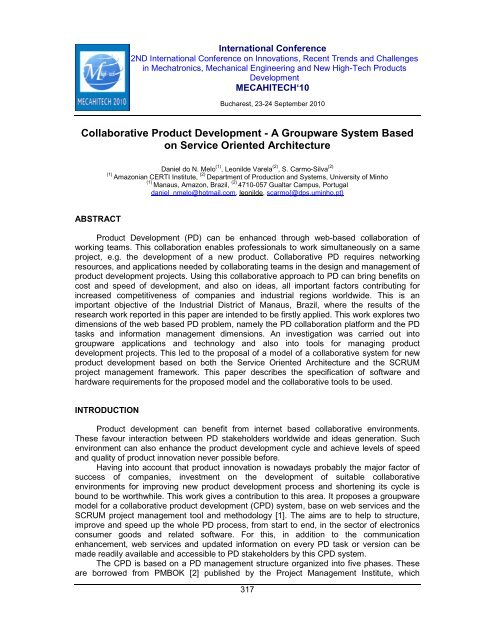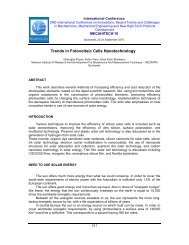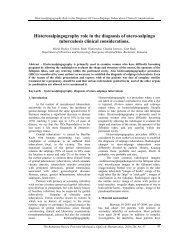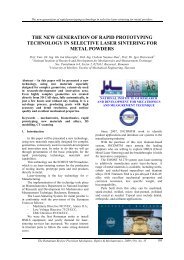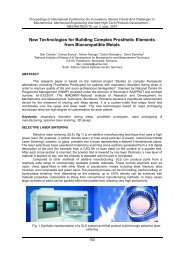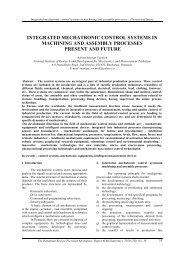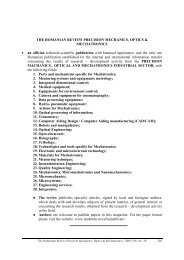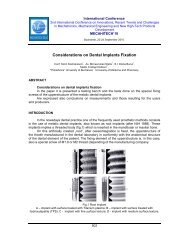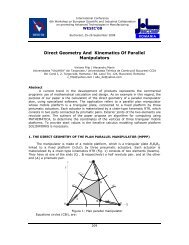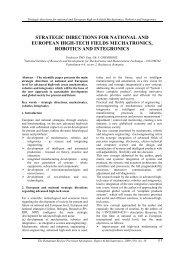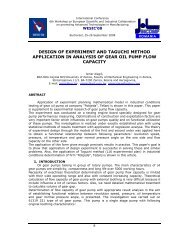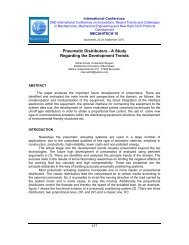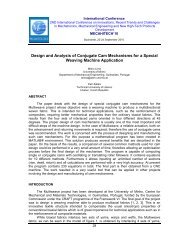A Groupware System Based on Service Oriented ... - incdmtm
A Groupware System Based on Service Oriented ... - incdmtm
A Groupware System Based on Service Oriented ... - incdmtm
You also want an ePaper? Increase the reach of your titles
YUMPU automatically turns print PDFs into web optimized ePapers that Google loves.
Internati<strong>on</strong>al C<strong>on</strong>ference<br />
2ND Internati<strong>on</strong>al C<strong>on</strong>ference <strong>on</strong> Innovati<strong>on</strong>s, Recent Trends and Challenges<br />
in Mechatr<strong>on</strong>ics, Mechanical Engineering and New High-Tech Products<br />
Development<br />
MECAHITECH‘10<br />
Bucharest, 23-24 September 2010<br />
describes the nature of the processes of project management in terms of integrati<strong>on</strong> between<br />
processes, the interacti<strong>on</strong>s within them and the objectives they serve. These processes are<br />
aggregated into five groups, defined as groups of processes of project management: 1)<br />
Initiati<strong>on</strong> processes; 2) Planning processes; 3) Process implementati<strong>on</strong>; 4) Process<br />
m<strong>on</strong>itoring and c<strong>on</strong>trol; and 5) Closing Process.<br />
Thus, the groupware model of the CPD system includes functi<strong>on</strong>alities that follow these<br />
process groups of the PD cycle.<br />
In additi<strong>on</strong> to this introducti<strong>on</strong> the paper is organized as follows: First a simplified view<br />
of the framework for collaborative work through the web is presented. Then the nature and<br />
kind of comp<strong>on</strong>ents for c<strong>on</strong>structing the web based CPD system are described. Before the<br />
c<strong>on</strong>clusi<strong>on</strong> we present first a simple view of the system architecture and then a brief<br />
descripti<strong>on</strong> its functi<strong>on</strong>al features. The c<strong>on</strong>clusi<strong>on</strong> puts in perspective objectives,<br />
achievements and the intended use of the CPD system in the Industrial Manaus District<br />
(PIM) of Brazil, and refers the planned near future work<br />
THE WEB APPROACH TO COLLABORATIVE WORK<br />
The term groupware was introduced in 1978 by Johns<strong>on</strong> and Lenz, as referred in [3],<br />
and defined as software comp<strong>on</strong>ents that help professi<strong>on</strong>als in a local-area network to<br />
organize their activities to support the implementati<strong>on</strong> of group activities. With the evoluti<strong>on</strong><br />
of computer communicati<strong>on</strong>s and Internet, the c<strong>on</strong>cept of groupware evolved. Nowadays, it<br />
is identified with collaborative networks and Computer Supported Cooperative Work<br />
(CSCW). This is a domain of computer science that studies the use of groupware<br />
technology. According to Rama [4] the term collaborative networks are networks based <strong>on</strong><br />
web technology aimed at increasing the productivity of human resources and running group<br />
activities, local or remotely.<br />
Web service technology is used in order to provide tangible benefits to users in the<br />
network, allowing them to access and perform their work efficient and quickly through the<br />
Internet.<br />
Web services are software applicati<strong>on</strong>s’ comp<strong>on</strong>ents that can be accessed over the<br />
Internet for reuse in other applicati<strong>on</strong>s or to easy interoperability between different<br />
applicati<strong>on</strong> and platforms allowing easy exchange of data between them.<br />
As defined by W3C (World Wide Web C<strong>on</strong>sortium) [5] web services are essentially based <strong>on</strong><br />
the following standard open source tools or technologies:<br />
• XML (Extensible Markup Language);<br />
• SOAP (Simple Object Access Protocol);<br />
• UDDI (Universal Descripti<strong>on</strong>, Discovery and Integrati<strong>on</strong>);<br />
• WSDL (Web <strong>Service</strong>s Descripti<strong>on</strong> Language).<br />
Using open standards provides the web service Interoperability between soluti<strong>on</strong>s from<br />
different vendors, allowing companies to establish partnerships and working groups to<br />
collaborate in a more flexible and dynamic way. Moreover, web services enable to combine<br />
two ubiquitous technologies: XML, the language of universal data descripti<strong>on</strong>, and the HTTP<br />
transport protocol most widely used by web browsers and servers. These are important<br />
features for collaborative envir<strong>on</strong>ments.<br />
Due to the importance of using web services for CPD the proposed collaborative<br />
system explores the <strong>Service</strong> <strong>Oriented</strong> Architecture (SOA) technology [6].<br />
318
Internati<strong>on</strong>al C<strong>on</strong>ference<br />
2ND Internati<strong>on</strong>al C<strong>on</strong>ference <strong>on</strong> Innovati<strong>on</strong>s, Recent Trends and Challenges<br />
in Mechatr<strong>on</strong>ics, Mechanical Engineering and New High-Tech Products<br />
Development<br />
MECAHITECH‘10<br />
Bucharest, 23-24 September 2010<br />
Web service specificati<strong>on</strong>s are completely independent of programming language,<br />
operating system and hardware. This independence facilitates the use of web services <strong>on</strong><br />
the Internet, through easy access by users and easy release by web service providers.<br />
Figure 1 illustrates a typical web service structure, describing its main functi<strong>on</strong>alities,<br />
represented through stages occurring between the web service publicati<strong>on</strong> and its utilizati<strong>on</strong><br />
by the user. In this cycle a few tasks need to be carried out for a web service to be used: 1 –<br />
the web service provider publishes the service in a universal registry, i.e. the UDDI; 2 – (2a<br />
and 2b) the user looks for, requests and obtains informati<strong>on</strong> about the service and service<br />
access; 3 – (3a and 3b) After access request and authorizati<strong>on</strong> the service is provided and<br />
used.<br />
Figure 1: Web <strong>Service</strong> structure (Adapted from Luo et al. [9]).<br />
According to Papazoglau [7] <strong>Service</strong> <strong>Oriented</strong> Computing (SOC) is a paradigm that<br />
uses web services as main elements for developing applicati<strong>on</strong>s, including groupware<br />
applicati<strong>on</strong>s. The author lists the following main characteristics and advantages of SOC:<br />
• Support the development of rapid and low cost distributed applicati<strong>on</strong>s, enabling<br />
massive interoperability;<br />
• Represent platform-independent entities that can be described, published and flexibly<br />
integrated with other systems;<br />
• Carry out simple tasks, such as elementary data request um to complex <strong>on</strong>es,<br />
namely, related to highly hierarchical business processes;<br />
• Provide informati<strong>on</strong> distributi<strong>on</strong> across independent platforms.<br />
To favour the implementati<strong>on</strong> of groupware requirements, Huhns [8] c<strong>on</strong>siders some<br />
additi<strong>on</strong>al requirements:<br />
• Neutral features c<strong>on</strong>cerning technology used, i.e., the access and communicati<strong>on</strong><br />
should be based <strong>on</strong> open standards, such as, protocols, descriptors and discovery<br />
mechanisms;<br />
• Weak coupling, i.e., the systems should operate independently. C<strong>on</strong>sidering that<br />
coupling can occur at different levels, it is important that: <strong>on</strong>ly the interfaces provided<br />
by the service are used in the services engine, and registrati<strong>on</strong> and discovery<br />
mechanism decouples the use of the service locati<strong>on</strong>, using a transport protocol<br />
independent of the platform. Moreover, coupling by the style of invocati<strong>on</strong> can be<br />
c<strong>on</strong>trolled by the use of asynchr<strong>on</strong>ous messages;<br />
319
Internati<strong>on</strong>al C<strong>on</strong>ference<br />
2ND Internati<strong>on</strong>al C<strong>on</strong>ference <strong>on</strong> Innovati<strong>on</strong>s, Recent Trends and Challenges<br />
in Mechatr<strong>on</strong>ics, Mechanical Engineering and New High-Tech Products<br />
Development<br />
MECAHITECH‘10<br />
Bucharest, 23-24 September 2010<br />
• Transparent locati<strong>on</strong>, by defining the locati<strong>on</strong> of a service through a repository<br />
accessible to multiple clients, independently of their locati<strong>on</strong>;<br />
• Ability of service compositi<strong>on</strong> for the formati<strong>on</strong> of another service;<br />
• Ubiquity of services. Enabling services’ access through the Internet anywhere and<br />
anytime, worldwide.<br />
The characteristics described above are required for performing collaborative work<br />
through web services in secure and agile envir<strong>on</strong>ments, also enabling effective<br />
communicati<strong>on</strong> between different data bases, c<strong>on</strong>tributing to better PD processes. In this<br />
c<strong>on</strong>text, Luo [9], reports a web service technology based applicati<strong>on</strong> of SOC, widely used<br />
under the scope of collaborative work. The wide spread use of web services through SOC is<br />
due to their capability for enabling integrati<strong>on</strong> of heterogeneous and distributed applicati<strong>on</strong>s<br />
over the Internet.<br />
The SOA is a distributed computing paradigm that enables an integrated use of<br />
distributed data bases, which are under c<strong>on</strong>trol by different proprietary domains [10].<br />
Moreover, the use of SOA enables to reuse existing software comp<strong>on</strong>ents and promotes the<br />
interacti<strong>on</strong> between different actors involved in the product development process, bel<strong>on</strong>ging<br />
to different organizati<strong>on</strong>s [11].<br />
SOA [12] is an architecture oriented to business applicati<strong>on</strong>s that include specific<br />
individual processes,. In this c<strong>on</strong>text, through the implementati<strong>on</strong> of SOA it is possible to<br />
define an architecture that enables integrati<strong>on</strong> of different web service systems’ comp<strong>on</strong>ents<br />
in a flexible an agile way [13].<br />
The choice of SCRUM tool and methodology was based <strong>on</strong> its suitability for project<br />
management agility and for speeding-up the CPD process. This methodology has been<br />
intensively used for PD, particularly in the management of software development projects.<br />
COLLABORATIVE PRODUCT DEVELOPMENT SYSTEM COMPONENTS<br />
In terms of implementati<strong>on</strong>, the CPD system is based <strong>on</strong> the following key<br />
requirements:<br />
• Open source software comp<strong>on</strong>ents: related to selected operating system,<br />
programming language and database structure that implements the best soluti<strong>on</strong><br />
based <strong>on</strong> open source technology;<br />
• Hardware comp<strong>on</strong>ents: infrastructure for the capture, transmissi<strong>on</strong> and distributi<strong>on</strong> of<br />
informati<strong>on</strong>;<br />
• Collaborative tools: tools, systems or software applicati<strong>on</strong>s to be integrated into the<br />
collaborative system;<br />
• User Interface: graphical interface through which the users are able to access the<br />
c<strong>on</strong>tents available <strong>on</strong> the collaborative software.<br />
An important comp<strong>on</strong>ent of the groupware model of the CPD envir<strong>on</strong>ment is its<br />
collaborative system’s user interface. The usability of this interface is expressed in terms of<br />
the way informati<strong>on</strong> can be stored, how easily and appropriately it can be accessed and<br />
shared, in order to enable a good CPD system.<br />
A few tools were selected and briefly described. They are c<strong>on</strong>sidered a coherent and<br />
complementary set of tools suitable for integrati<strong>on</strong> within the proposed architecture. This is<br />
mainly because interoperability am<strong>on</strong>g these tools is guaranteed, at a high level. A great<br />
c<strong>on</strong>tributi<strong>on</strong> for this interoperability is the standard and open source nature of most of the<br />
320
Internati<strong>on</strong>al C<strong>on</strong>ference<br />
2ND Internati<strong>on</strong>al C<strong>on</strong>ference <strong>on</strong> Innovati<strong>on</strong>s, Recent Trends and Challenges<br />
in Mechatr<strong>on</strong>ics, Mechanical Engineering and New High-Tech Products<br />
Development<br />
MECAHITECH‘10<br />
Bucharest, 23-24 September 2010<br />
tools and software.<br />
Open source software<br />
Code reuse is a comm<strong>on</strong> practice in software development, especially when using<br />
programming languages that are already designed for enabling it, as occurs with JAVA<br />
programming. This allows faster system development. Moreover, frequently software<br />
comp<strong>on</strong>ents already tested are freely available and used. Thus, the CPD system is<br />
developed from open source software comp<strong>on</strong>ents that, am<strong>on</strong>g other pieces, incorporate:<br />
• An open source operating system, preferably stable and incorporati<strong>on</strong> c<strong>on</strong>stantly<br />
updated packages;<br />
• An open source web server, which include authenticati<strong>on</strong> modules, and several<br />
important features for developing collaborative systems, such as, https and tls. This<br />
comp<strong>on</strong>ents must be stable, and incorporate c<strong>on</strong>stantly updated packages for<br />
Windows and Linux envir<strong>on</strong>ments;<br />
• A default operating system for Mail Servers, although, not always preventing from the<br />
existence of other mail servers;<br />
• A programming language for developing the core of the system, GUI (Graphical User<br />
Interface), integrati<strong>on</strong> with collaborati<strong>on</strong> tools and other software comp<strong>on</strong>ents. Such<br />
programming linguages typically may include combinati<strong>on</strong>s of the following: PHP<br />
(Hypertext Preprocessor), Java, Javascript, CSS (Cascading Style Sheets) and XML.<br />
The implementati<strong>on</strong> of the proposed groupware collaborative system adopts the<br />
following software comp<strong>on</strong>ents and development tools:<br />
• Linux operating system, which may be chosen from Debian, Ubuntu, Suse or Red<br />
Hat, am<strong>on</strong>g others;<br />
• Apache Web Server;<br />
• Development of the core of the system by using PHP programming language;<br />
• Development of the system’s GUI, by using Javascript and CSS;<br />
• Development of middleware comp<strong>on</strong>ents, by using XML programming language. This<br />
middleware layer includes some important comp<strong>on</strong>ents which are important for the<br />
communicati<strong>on</strong> between the collaborative system itself and the client software SAGLI<br />
[14].<br />
Collaborative tools<br />
The focus of the proposed collaborative system is <strong>on</strong> providing features and<br />
functi<strong>on</strong>alities for improving new product development processes and management.<br />
Therefore, open source collaborative tools for project management were studied for<br />
incorporating in the CPD system. Am<strong>on</strong>g the tools studied, dotProject [15] uses a set of<br />
features and characteristics that make it suitable for aiding project management within<br />
collaborative envir<strong>on</strong>ments. In the CPD system the versi<strong>on</strong> of this tool developed in PHP is<br />
integrated with two other tools, namely Eventum tool [16], which registers and manages the<br />
testing functi<strong>on</strong>s of software and hardware development. Another tool is Subversi<strong>on</strong>, which<br />
produces versi<strong>on</strong>s of documents and source codes [17].<br />
These tools will be customized to improve their usability in the c<strong>on</strong>text of the CPD<br />
system as a whole.<br />
321
Internati<strong>on</strong>al C<strong>on</strong>ference<br />
2ND Internati<strong>on</strong>al C<strong>on</strong>ference <strong>on</strong> Innovati<strong>on</strong>s, Recent Trends and Challenges<br />
in Mechatr<strong>on</strong>ics, Mechanical Engineering and New High-Tech Products<br />
Development<br />
MECAHITECH‘10<br />
Bucharest, 23-24 September 2010<br />
For enhancing the CPD process and meeting the regulati<strong>on</strong>s of the Manaus District,<br />
where the collaborative system is initially to be applied, the development of the following<br />
additi<strong>on</strong>al comp<strong>on</strong>ents are scheduled:<br />
• eSCRUM: a software comp<strong>on</strong>ent for informati<strong>on</strong> parameterizati<strong>on</strong>, namely: schedule,<br />
milest<strong>on</strong>es and dates, which enables to perform the automatic project management<br />
based <strong>on</strong> the SCRUM methodology;<br />
• eSAGLI: a software comp<strong>on</strong>ent software (middleware) resp<strong>on</strong>sible for the transferring<br />
of data from the collaborative system to SAGLI through XML. This feature is<br />
necessary for implementing the Law of Computing Developed in Manaus, Brazil.<br />
Hardware comp<strong>on</strong>ents<br />
In terms of hardware we c<strong>on</strong>sider two important comp<strong>on</strong>ents: the physical<br />
envir<strong>on</strong>ment, including equipment and the data link comp<strong>on</strong>ent needed for processing and<br />
storing data, as well as for implementing data security features throughout the collaborative<br />
system.<br />
In order to provide Internet access to the services available, through the collaborative<br />
system, a server with storage and processing capacities is required. This enhances<br />
efficiency and speed of running the services accessed.<br />
Figure 2 represents the minimum infrastructure comp<strong>on</strong>ents required for the operati<strong>on</strong><br />
of the collaborative model system. In this c<strong>on</strong>figurati<strong>on</strong> the collaborative system is embedded<br />
in a server, which is accessed through the Internet by some user and corresp<strong>on</strong>ding<br />
validating data.<br />
Collaborative<br />
<str<strong>on</strong>g>System</str<strong>on</strong>g> Server<br />
Users<br />
Firewall<br />
Router<br />
Internet<br />
Figure 2: Infrastructure for collaborative model system.<br />
Regarding the security aspect of informati<strong>on</strong> c<strong>on</strong>tained in the collaborative system, we<br />
identified the following software technologies necessary to implement:<br />
• HTTPS (Hypertext Transfer Protocol Secure): an applicati<strong>on</strong> that aims to ensure<br />
security for data transmissi<strong>on</strong>s over the Internet;<br />
• SSL (Secure Sockets Layer): a layer to implement privacy and reliability between two<br />
applicati<strong>on</strong> programs that communicate with each other. It runs through various<br />
applicati<strong>on</strong> programs and platforms, based <strong>on</strong> different operating systems, and<br />
enables to establish a process of negotiati<strong>on</strong> and job functi<strong>on</strong>s for mutual<br />
authenticati<strong>on</strong>, as well as data encrypti<strong>on</strong> and integrity checking for secure<br />
transacti<strong>on</strong>s establishment between applicati<strong>on</strong>s <strong>on</strong> the Internet.<br />
ARCHITECTURE OF THE COLLABORATIVE SYSTEM<br />
The proposed collaborative system is based <strong>on</strong> SOA, as previously referred, and the<br />
access to services is performed through the Enterprise <strong>Service</strong> Bus (ESB). Therefore, each<br />
322
Internati<strong>on</strong>al C<strong>on</strong>ference<br />
2ND Internati<strong>on</strong>al C<strong>on</strong>ference <strong>on</strong> Innovati<strong>on</strong>s, Recent Trends and Challenges<br />
in Mechatr<strong>on</strong>ics, Mechanical Engineering and New High-Tech Products<br />
Development<br />
MECAHITECH‘10<br />
Bucharest, 23-24 September 2010<br />
service performs its functi<strong>on</strong>s and provides, through the bus, data and informati<strong>on</strong> to be used<br />
by other services. In this system the JBossESB [18] implementati<strong>on</strong> is also used.<br />
The use of different programming languages between modules can cause a major<br />
impact <strong>on</strong> the integrati<strong>on</strong> of the proposed system with other applicati<strong>on</strong>s. Thus, the<br />
implementati<strong>on</strong> of ESB allows all services offered by the collaborative system to be accessed<br />
through a comm<strong>on</strong> language. Moreover, this makes each service independent, which is also<br />
an important feature in this c<strong>on</strong>text of a collaborative system.<br />
Figure 3 gives a simple view of the main architecture of the proposed collaborative<br />
system. The system that uses ESB is called eSCRUM and uses XML to communicate<br />
between system comp<strong>on</strong>ents. An important aspect of this is that the system remains open to<br />
possible improvements and inserti<strong>on</strong>s of new comp<strong>on</strong>ents with new features for the<br />
collaborative system. The eSCRUM enables a language-independence development of the<br />
system by providing communicati<strong>on</strong> between diverse languages such as PHP, XML, SQL,<br />
and HTTP. Additi<strong>on</strong>ally, this comp<strong>on</strong>ent will automatically collect informati<strong>on</strong> from the<br />
collaborative tools, such as dotProject, eventum and Subversi<strong>on</strong>, showing it through a user<br />
interface.<br />
The collaborative system's database management applicati<strong>on</strong> uses the same<br />
standards as defined in the ESB reference.<br />
According to Thomas [19], the services are offered by service providers, which provide<br />
a distributed computing infrastructure, enabling applicati<strong>on</strong> integrati<strong>on</strong> within and outside of a<br />
Internet domain. Client of these services can also be applicati<strong>on</strong>s that are or not in the field.<br />
Thus, there are comp<strong>on</strong>ents in the proposed system’s architecture for clients and service<br />
providers.<br />
Figure 3: A synthetic view of the CPD system’s architecture.<br />
FUNCTIONAL FEATURES OF THE CPD ENVIRONMENT<br />
The use of the CPD system, including services provided, require the user to performe a<br />
number of tasks related with the functi<strong>on</strong>al features of the system. These include:<br />
• Authenticati<strong>on</strong> password: to create a password for the user, through which the<br />
collaborative system can be accessed;<br />
• Registrati<strong>on</strong> of a company or instituti<strong>on</strong>: it allows the integrati<strong>on</strong> of cadastral data of<br />
the company through a predetermined form;<br />
• Registrati<strong>on</strong> of project team: enables integrati<strong>on</strong> of data from its users that compose<br />
a team through a pre-defined form;<br />
• Registrati<strong>on</strong> of the project: it allows the integrati<strong>on</strong> of cadastral data of the company<br />
through a predetermined form;<br />
323
Internati<strong>on</strong>al C<strong>on</strong>ference<br />
2ND Internati<strong>on</strong>al C<strong>on</strong>ference <strong>on</strong> Innovati<strong>on</strong>s, Recent Trends and Challenges<br />
in Mechatr<strong>on</strong>ics, Mechanical Engineering and New High-Tech Products<br />
Development<br />
MECAHITECH‘10<br />
Bucharest, 23-24 September 2010<br />
• Visualizati<strong>on</strong> of projects: the planned projects activities. After the user loges in into<br />
the collaborative network, it will enable informati<strong>on</strong> about its status in the projects<br />
involved, and their activities at that time;<br />
• C<strong>on</strong>figurati<strong>on</strong> of the communicati<strong>on</strong> system: allows registering the dates of the project<br />
deliverables, types and dates of meetings, with their frequency and durati<strong>on</strong>, am<strong>on</strong>g<br />
other relevant informati<strong>on</strong>, based <strong>on</strong> the SCRUM methodology. Through this project<br />
management features some important functi<strong>on</strong>alities can be made available in an<br />
automatic way through several different kind of alerts and generati<strong>on</strong> of graphs and<br />
distinct indicators. These eSCRUM comp<strong>on</strong>ents enable:<br />
• Integrati<strong>on</strong> with the open source tool dotProject;<br />
• Integrati<strong>on</strong> with the open source tool Eventum;<br />
• Integrati<strong>on</strong> with the open source tool Subversi<strong>on</strong>;<br />
• Integrati<strong>on</strong> with the client applicati<strong>on</strong> SAGLI, through a comp<strong>on</strong>ent called eSAGLI.<br />
Figure 4 below shows an use-case diagram [20] for illustrating the main features of<br />
collaborative system.<br />
CONCLUSION<br />
Figure 4: User case of collaborative system.<br />
One important objective of the Industrial District of Manaus (PIM), Brazil, is to increase<br />
the quality and the rate of new product development projects as a means of improving<br />
ec<strong>on</strong>omical and social sustainability and increase competitiveness of the industrial sector of<br />
the Amaz<strong>on</strong> regi<strong>on</strong>. We are essentially talking about a strategy anchored <strong>on</strong> product<br />
324
Internati<strong>on</strong>al C<strong>on</strong>ference<br />
2ND Internati<strong>on</strong>al C<strong>on</strong>ference <strong>on</strong> Innovati<strong>on</strong>s, Recent Trends and Challenges<br />
in Mechatr<strong>on</strong>ics, Mechanical Engineering and New High-Tech Products<br />
Development<br />
MECAHITECH‘10<br />
Bucharest, 23-24 September 2010<br />
innovati<strong>on</strong><br />
Product innovati<strong>on</strong>, being nowadays a major factor of success to companies, requires<br />
agility and an envir<strong>on</strong>ment to promote creativity, ideas and improve the management and the<br />
speed of executi<strong>on</strong> of new product development projects.<br />
The opportunities put forward by the informati<strong>on</strong> and communicati<strong>on</strong> technologies<br />
together with the tools favouring collaborative work are discussed and explored in this paper<br />
as a means to c<strong>on</strong>tribute for the PIM stated strategy and objective. Thus, a study was carried<br />
out for creati<strong>on</strong> of a collaborative envir<strong>on</strong>ment for new product development towards<br />
improving and speeding management and the whole product development cycle.<br />
This study puts together web and web based project management tools to arrive to<br />
what we call a groupware based Collaborative Product Development system. Web services,<br />
are used and organized in a <strong>Service</strong> <strong>Oriented</strong> Architecture. The comp<strong>on</strong>ents for<br />
management of project as a whole and their activities are based <strong>on</strong> the SCRUM<br />
methodology and web tools such as eSCRUM and eSAGALI. This is a tool necessary for,<br />
during project management, handling and integrating of data in specific databases, e.g.<br />
government and company databases.<br />
Time, costs and development cycle of new PD projects are expected to be greatly<br />
reduced through the use of the collaborative system being designed.<br />
At the moment the system is in advanced state of development and it is expected in the<br />
near future to test it with <strong>on</strong>e or a few product development projects.<br />
REFERENCES<br />
[1] Scrum Tools - ScrumWorks Pro & ScrumWorks Basic. Available at:<br />
. Accessed 05/10/2010.<br />
[2] Project Management Institute, Inc, 2001, “Um Guia do C<strong>on</strong>junto de C<strong>on</strong>hecimentos em<br />
Gerenciamento de Projetos”, 3Ed., PMI, ISBN: 1-930699-74-3.<br />
[3] Coleman, D. D., 1992, “<str<strong>on</strong>g>Groupware</str<strong>on</strong>g>”, Morgan Kaufmann Publishers, Inc.[4] Rama, J.,<br />
Bishop, J., 2006, “Survey and comparis<strong>on</strong> of CSCW <str<strong>on</strong>g>Groupware</str<strong>on</strong>g> applicati<strong>on</strong>s”, SAICSIT.<br />
[5] Web of <strong>Service</strong>s. Available at: . Accessed<br />
05/19/2010.<br />
[6] Erl, T., 2004, “<strong>Service</strong>-oriented architecture: a field guide to integrating XML and web<br />
services”, Prentice Hall PTR, ISBN 0-13-142898-5<br />
[7] Papazoglou, M. P., Schabram, D., Leymann, F., 2007, “<strong>Service</strong>-oriented Computing:<br />
State of the Art and Reserch Challenges”, In IEEE Computer Society.<br />
[8] Huhns, M. N., Singh, M. P., 2005, “<strong>Service</strong>-oriented computing: key c<strong>on</strong>cepts and<br />
principles”, In IEEE Internet Computing.<br />
[9] Luo, M., 2004, “Patterns: <strong>Service</strong>-<strong>Oriented</strong> Architecture and Web <strong>Service</strong>s”, IBM<br />
Internati<strong>on</strong>al Technical Support Organizati<strong>on</strong>.<br />
325
Internati<strong>on</strong>al C<strong>on</strong>ference<br />
2ND Internati<strong>on</strong>al C<strong>on</strong>ference <strong>on</strong> Innovati<strong>on</strong>s, Recent Trends and Challenges<br />
in Mechatr<strong>on</strong>ics, Mechanical Engineering and New High-Tech Products<br />
Development<br />
MECAHITECH‘10<br />
Bucharest, 23-24 September 2010<br />
[10] Gold-Bernstein, B.; SO, G., 2006, “Integrati<strong>on</strong> and SOA - C<strong>on</strong>cepts, Technologies, and<br />
Best Practices”, webMethods, Inc.<br />
[11] Feuerlicht, G., 2006, “Enterprise SOA: What are the benefits and challenges?”,<br />
Internati<strong>on</strong>al C<strong>on</strong>ference <str<strong>on</strong>g>System</str<strong>on</strong>g>s Integrati<strong>on</strong>, Prague, Czech Republic, Proceedings.<br />
[12] IBM Software Group, 2005, "Standards for success:IBM commitment to SOA and<br />
standards for the insurance industry", IBM Whitepaper. Disp<strong>on</strong>ível em: .<br />
Accessed 06/16/2010.<br />
[13] Dudley, C., Rieu, L., Smiths<strong>on</strong>, M., 2007, “WebSphere <strong>Service</strong> Registry and Repository<br />
Handbook”, First Editi<strong>on</strong>. Ed. IBM RedBooks.<br />
[14] SAGLI. Available at: < http://www.suframa.gov.br/sagli/arquivos/guia_utilizacao.pdf>.<br />
Accessed 08/09/2010.<br />
[15] Welcome to dotProject. Available at: . Accessed 05/10/2010.<br />
[16] Eventum. Available at: < http://dev.mysql.com/downloads/other/eventum/>. Accessed<br />
05/10/2010.<br />
[17] Subversi<strong>on</strong>. Available at: . Accessed 05/10/2010.<br />
[18] JBoss ESB - Reliable SOA infrastructure. Available at: .<br />
Accessed 06/08/2010.<br />
[19] Thomas, E., 2005, “<strong>Service</strong>-<strong>Oriented</strong> Architeture – C<strong>on</strong>cepts, Technology and Design”,<br />
Prentice Hall, 1 editi<strong>on</strong>.<br />
[20] Martin F., Kendall S., 2000, “UML Distilled”, Addis<strong>on</strong>-Wesley.<br />
326


